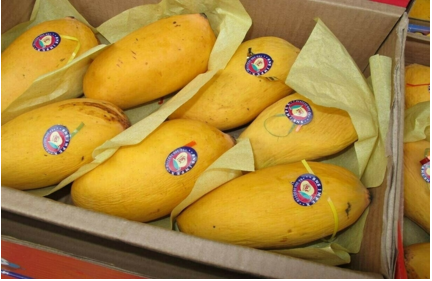i INP-WEALTHPK
Shujauddin Qureshi
Despite challenges posed by climate change and water shortages, Sindh's mango farmers and exporters remain optimistic about reaching the $100 million export target this year.

Talking to WealthPK, Ali Palh, a top mango grower and Chairman Sindh Agricultural Research Council (SARC), said, "Sindh's mango production has gone down this year because the temperatures in its lower mango-growing areas stayed as high as 48 degrees Celsius in April and May."
He said when the flowering was at its peak, the tail-enders did not get enough water due to the reduced flow of water in the Indus, thus hurting the fruit growth. Even with these problems, early-season growers were able to fetch decent prices for their produce; however, later-season producers suffered losses because the hot weather affected the crop size and taste, he said.
Palh said the good thing that happened this year was that the exporters bought the fresh crop straight from the growers. Earlier, the contractors or intermediaries paid the growers less for their crop. Palh said the producers can make even more money if they start exporting their crop directly.
“Since Sindh’s growers lack training and experience, they are unable to directly export their produce. Even mango pickers and packers come from Southern Punjab every year. During the COVID-19 lockdown, when workers from Punjab could not reach Sindh’s farms, we tried to train our youth but could not succeed due to the lack of government support,” said Palh.
The exporters want to export 125,000 metric tons of mangos worth $100 million this year. Pakistan grows over 300 varieties of mango because of its many climate zones. However, the commercial production concentrates mostly on high-quality types, including Sindhri, Chaunsa, Anwar Ratol, and Langra. Sindh’s mango ripens in May, and the early variety of Sindhri remains in high demand in and outside the country. Southern Punjab’s Chaunsa comes after 15th June, having more sweetness and taste.
According to the Pakistan Fruit and Vegetable Exporters Association (PFVA), mango production is steadily going down countrywide because of climate change and lack of water. They said the total mango production could drop by as much as 20% this year due to these factors. Waheed Ahmed, Patron-in-Chief of PFVA, said in a statement that about 70% of production originates from Punjab and 29% from Sindh.
The Trade Development Authority of Pakistan (TDAP) has pledged increased support for mango exporters, including facilitating their participation in international trade exhibitions. According to the TDAP, Pakistan is the fourth-largest mango grower in the world, producing about 1.8 million tons of fruit each year. In 2023, over 125,000 tons of fruit was exported, bringing in around $100 million in export earnings.
The Pakistani embassy in the United Arab Emirates organized a mango festival in Abu Dhabi in June this year to promote the country's fruit exports. The mission noted that the demand for Pakistani mango was still rising across the Gulf. The UAE, Saudi Arabia, Japan, and Turkey are major buyers of Pakistani mango. Some exporters tried to ship mango to the US, but the long distance and higher shipping costs discouraged them.
Talking to WealthPK, Dr. Muhammad Ismail Kumbhar, a lecturer at the Sindh Agriculture University, Tando Jam, said, "Our varieties like Sindhri and Chaunsa are in high demand overseas because of their unique taste and aroma." Prof. Kumbhar says the main problems facing the growers are inadequate facilities to manage the crop after harvest, and lack of research and cold storage facilities. The contractors have a lot of control over cold storage facilities, which hurts the fruit quality.
As the mango season is ongoing and different varieties from Southern Punjab are coming to the market, the exporters have also geared up to send their consignments abroad. The production may drop by as much as 20% this year, needing new supply chain management ideas and government backing.
Credit: INP-WealthPk








